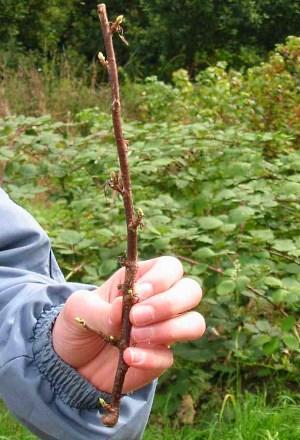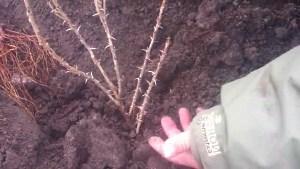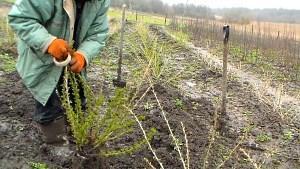How to propagate gooseberries by cuttings?
 Propagating gooseberries by cuttings is the best way to increase the number of bushes in your backyard. Despite the availability of other methods, this option is popular not only with experienced, but also novice gardeners. You just need to know how to propagate gooseberries by cuttings correctly, so that in the very next few years you can enjoy the rich harvest of berries.
Propagating gooseberries by cuttings is the best way to increase the number of bushes in your backyard. Despite the availability of other methods, this option is popular not only with experienced, but also novice gardeners. You just need to know how to propagate gooseberries by cuttings correctly, so that in the very next few years you can enjoy the rich harvest of berries.
Propagation by lignified cuttings?
When planning the propagation of gooseberries by cuttings, cuttings up to 20 cm long are cut in the fall, choosing basal or overgrown shoots. The handle should have at least 4 - 5 buds. Preference should be given to mother plants, the age of which does not exceed 10 years. It is important to check the absence of any diseases in the selected bush. Cuttings that have been cut from the top of the branch are believed to root best. The most productive rooting is characteristic of such cuttings.
Cuttings cut in the fall for propagation are placed in a glacier for the winter. They are planted in loose soil in May, leaving at least one bud on the surface. After that, the soil must be sprinkled with a layer of sawdust, peat or covered with foil.
 Before planting the prepared cuttings in the nursery, you should definitely keep them in water for a day. The use of special solutions that stimulate root formation will significantly increase the percentage of established seedlings.
Before planting the prepared cuttings in the nursery, you should definitely keep them in water for a day. The use of special solutions that stimulate root formation will significantly increase the percentage of established seedlings.
Throughout the growing season, it is necessary to feed the seedlings with solutions mineral fertilizers
What you need to know about gooseberry propagation by green cuttings?
Green cuttings are rightfully considered the most effective way to propagate gooseberries, allowing you to achieve the best result. The optimal time for gooseberry propagation by green cuttings depends on a number of factors, the main of which is the weather. Experienced gardeners recommend performing the necessary manipulations in the second half of June.
 For cuttings of gooseberries, in this case, use young growths that have appeared in the current year. It is best to harvest early in the morning or late in the evening. During the day, slicing is possible only on cloudy days. Use a sharp knife or blade to cut.
For cuttings of gooseberries, in this case, use young growths that have appeared in the current year. It is best to harvest early in the morning or late in the evening. During the day, slicing is possible only on cloudy days. Use a sharp knife or blade to cut.
The length of each cutting should be within 7 - 12 cm.In order for rooting to be successful, the prepared cuttings should be lowered in slices into the growth regulator, the temperature of which is about 20-24aboutC, and hold for 12 hours - days. After the specified time has elapsed, the slices must be rinsed with running water, and the cuttings should be planted in a nursery, deepening to a depth of about 1.5 cm and watered.
 The soil for the nursery deserves special attention. It should be prepared in advance. To do this, first, a drainage layer is laid, allowing excess moisture to be removed. Its presence is mandatory, since this culture is not among the moisture-loving ones. Then follows a layer of fertile soil, the thickness of which is enough to make about 10 cm. A mixture consisting of an equal amount of sand or perlite with peat or humus is laid on top.
The soil for the nursery deserves special attention. It should be prepared in advance. To do this, first, a drainage layer is laid, allowing excess moisture to be removed. Its presence is mandatory, since this culture is not among the moisture-loving ones. Then follows a layer of fertile soil, the thickness of which is enough to make about 10 cm. A mixture consisting of an equal amount of sand or perlite with peat or humus is laid on top.
When starting rooting, it is imperative to create favorable conditions: it must be warm with a high level of humidity. That is why:
- It is necessary to plant cuttings at a time when the night temperature does not drop below 16aboutC. For watering the seedlings, use warm water;
- Overheating should not be allowed. On hot days, the nursery must be opened and shaded using a special covering material or a piece of cloth;
- It is necessary to control the presence of moisture on the leaves.
After the roots appear, caring for the seedlings will consist in constant weeding and loosening of the soil. In this case, it is imperative to reduce the humidity level to a value close to the ambient air humidity level. If necessary, you can feed the planted shrub urea or slurry solution.
Method for green cuttings of gooseberries - video
Features of gooseberry propagation by combined cuttings
Owners of home gardens, faced with the need to increase plantings, often resort to the method of planting lignified or green cuttings. Meanwhile, there is a way that combines these two methods. We are talking about a combined cutting, which is a green shoot that has a part of last year's lignified growth, up to 4 cm long.
These are, as a rule, cuttings that have:
- Heel. Such a stalk is obtained by simply breaking out a branch;
- Crutch. In this case, the green branch is initially cut off with a part of the lignified shoot, and the cut itself is formed according to the characteristic brown growth of the last year;
- Stand. The stalk is harvested from a lateral branch, and the lignified shoot is located perpendicular to the green branch.
 It is important to know that there are some peculiarities of gooseberry propagation by cuttings of this species. For example, this method has been actively used since the end of May. It was at this time that green growths have a length of at least 5 cm. If necessary, cuttings can be obtained throughout the entire period of active growing season.
It is important to know that there are some peculiarities of gooseberry propagation by cuttings of this species. For example, this method has been actively used since the end of May. It was at this time that green growths have a length of at least 5 cm. If necessary, cuttings can be obtained throughout the entire period of active growing season.
After the combined stalk is cut off, it can be immediately transplanted into a previously well-loosened and moistened soil. It is necessary to deepen the "heel" by 3-4 cm. After that, the cutting is watered abundantly, and the soil is mulched. If these conditions are met, root formation can be expected after two weeks.
Thus, there are various options for obtaining cuttings and a special technology for their germination. Knowing how to breed gooseberries with cuttings, it will be possible to get seedlings from existing bushes without risking being deceived in the market regarding plant varieties and its taste characteristics.